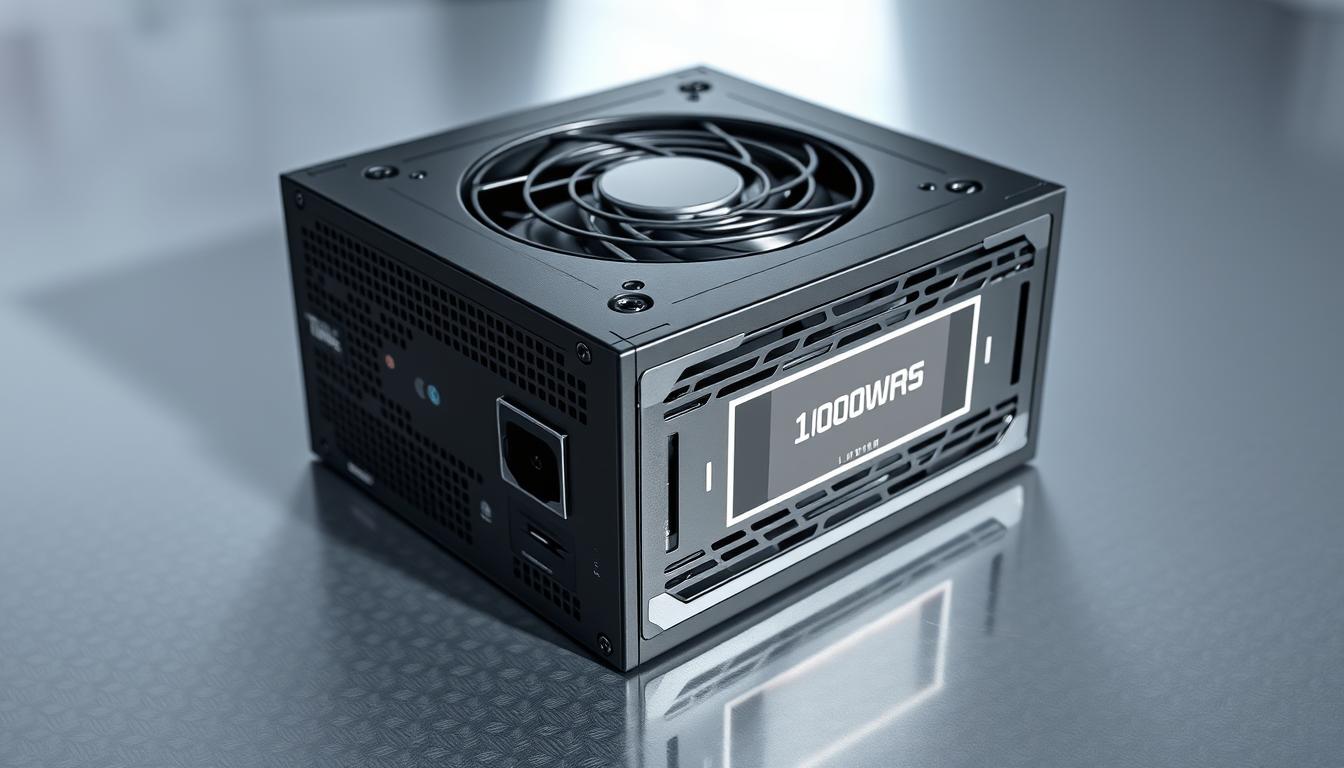
Did you know that a high-end CPU and GPU can consume over 600 watts combined? Add in other components, and your system’s power needs can skyrocket. This is why selecting the right power supply is critical for any gaming rig. The PSU is the backbone of your system, ensuring stability and longevity for all your hardware components1.
Modern gaming setups demand more power than ever before. High-performance GPUs, advanced cooling systems, and multiple storage drives can push mid-range PSUs to their limits. A 1000W unit offers the headroom needed for these power-hungry components, ensuring smooth operation even under heavy load2.
This article dives into the technical specifications, efficiency ratings, and future-proofing benefits of 1000W PSUs. Whether you’re building a new system or upgrading an existing one, understanding these factors can help you make an informed decision. Explore our detailed guide to find the perfect match for your needs.
Understanding 1000W Power Supplies
Modern gaming rigs often require a robust power solution to support advanced hardware components. A 1000W power supply is designed to meet these demands, ensuring stability and reliability even under heavy loads3.
High-end GPUs and CPUs can consume significant energy, often exceeding 600 watts when combined. Add in other components like cooling systems and storage drives, and the total power needs can escalate quickly3.
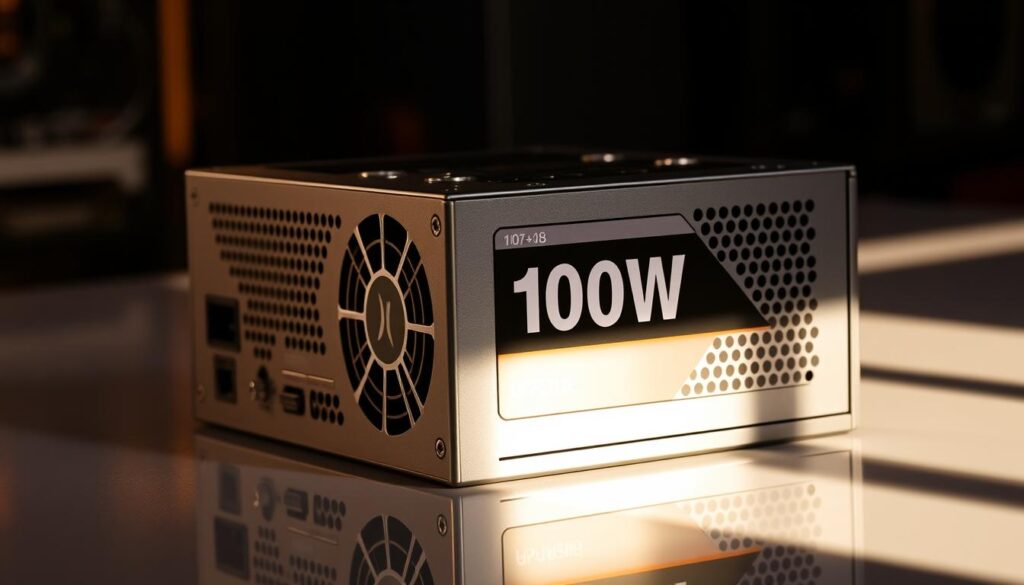
Efficiency ratings, such as 80 Plus Gold, indicate how well a PSU converts electricity into usable power. Higher ratings mean less energy waste and lower operating costs4.
Built-in protections like overcurrent (OCP) and overvoltage (OVP) safeguard your hardware from potential damage. These features are critical for maintaining the longevity of your system3.
Manufacturers rigorously test PSUs to ensure they meet industry standards. Certifications like 80 Plus provide a benchmark for efficiency and reliability4.
ATX 3.0 specifications ensure compatibility with modern hardware, including the latest GPUs and motherboards. This future-proofs your build, allowing for seamless upgrades5.
| Series | Wattage | Efficiency Rating |
|---|---|---|
| RMx Series | 1000W | 80 Plus Gold |
| RMe Series | 1000W | 80 Plus Gold |
| AXi Series | 1600W | 80 Plus Titanium |
Real-world benchmarks show that a 1000W unit performs optimally under heavy loads, making it an ideal choice for high-performance systems5.
Key Features to Consider in a Gaming PSU
The backbone of any high-performance system is its ability to handle the demands of modern hardware. A power supply plays a pivotal role in ensuring stability and longevity for all components. When selecting a PSU, several key features should be evaluated to match your system’s needs.
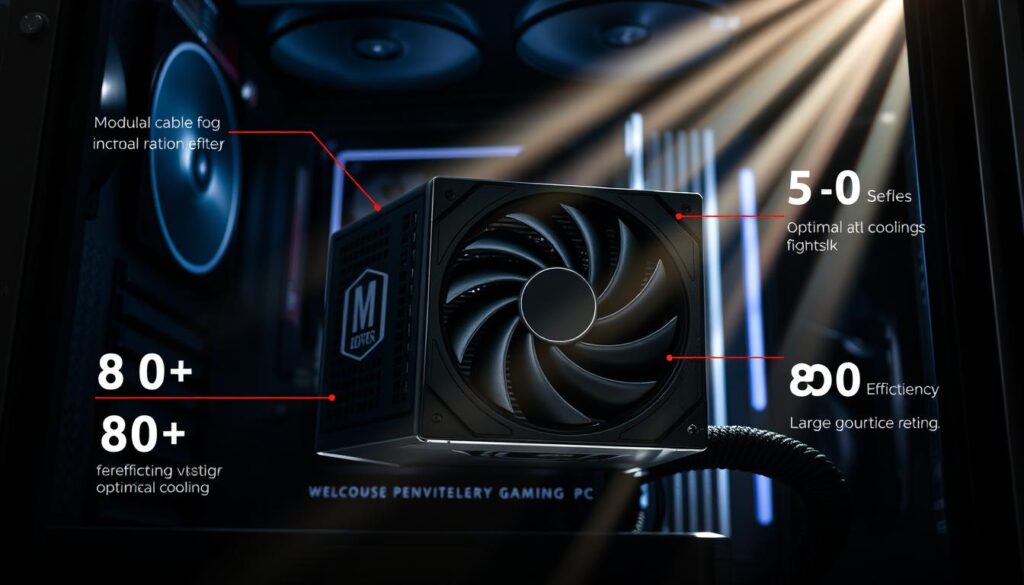
Efficiency, Safety, and Protection
Efficiency ratings, such as 80 Plus Gold or Platinum, indicate how well a PSU converts AC power into usable DC power. Higher ratings mean less energy waste and lower operating costs over time6. For example, premium models like the ROG Strix 1200W Platinum exceed 80 Plus Platinum requirements, ensuring optimal performance7.
Safety features are equally important. Protective circuits like overcurrent (OCP), overvoltage (OVP), and short-circuit protection (SCP) safeguard both the PSU and other components from potential damage. These features are critical for maintaining the reliability of your system7.
Modular vs Non-Modular Designs
Modular PSUs allow users to connect only the cables they need, improving airflow and reducing clutter inside the case. This design is ideal for systems with limited space or those prioritizing cable management6. Non-modular units, while often more affordable, come with fixed cables, which can make installation more challenging.
Real-world examples show that modular designs, like those in the ROG Thor series, offer better thermal performance and easier upgrades7. For more insights on modular PSUs, check out this detailed guide.
When choosing a PSU, consider factors like efficiency, safety, and design to ensure it meets your system’s requirements. For a comprehensive review of top PSU models, explore this expert analysis.
Reviewing Top Models: A Product Roundup
Selecting the right PSU can make or break your system’s performance. With so many options available, it’s essential to compare key features like efficiency, warranty, and modularity. This roundup highlights top models to help you make an informed choice.
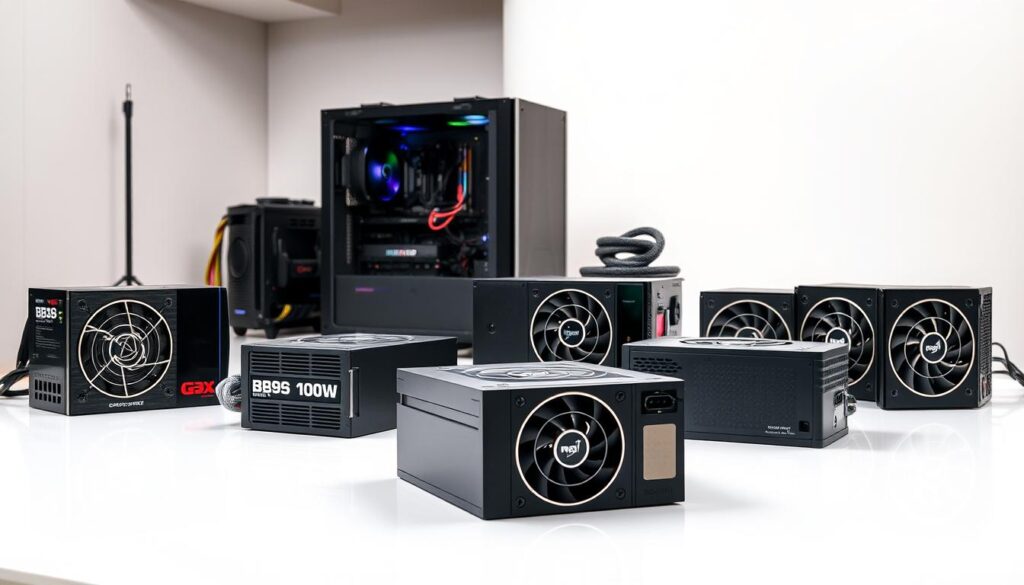
The MSI MAG A550BN is a budget-friendly option priced at $50, offering a 5-year warranty and 80Plus Bronze certification. It’s ideal for mid-range builds that don’t require extreme wattage8.
For those seeking premium quality, the be quiet! Dark Power 13 1000W stands out. Priced at $270, it frequently drops to $220 during sales. Its 80Plus Titanium certification ensures top-tier efficiency8.
“A reliable PSU ensures your hardware runs smoothly under heavy loads.”
The Enermax PlatiGemini 1200W is another high-performance choice, achieving up to 93.2% average efficiency. Priced at $250, it’s a solid option for demanding setups8.
| Model | Wattage | Efficiency | Price |
|---|---|---|---|
| MSI MAG A550BN | 550W | 80Plus Bronze | $50 |
| be quiet! Dark Power 13 | 1000W | 80Plus Titanium | $270 |
| Enermax PlatiGemini | 1200W | 93.2% Efficiency | $250 |
When choosing a power supply, consider factors like warranty, efficiency, and modularity. These features ensure your system remains stable and future-proof9.
Performance and Efficiency Ratings
Efficiency and performance are critical factors when evaluating a PSU’s capabilities. These metrics determine how well a unit converts electricity into usable energy and how it performs under various loads. Understanding these aspects ensures you choose a reliable and future-proof solution.
80 Plus and Beyond: Certification Standards
The 80 Plus certification is a benchmark for efficiency in power supplies. Ratings like Bronze, Gold, Platinum, and Titanium indicate how much energy is wasted during conversion. For example, an 80 Plus Gold unit ensures at least 90% efficiency at typical loads, reducing energy costs and heat output10.
Higher certifications, such as Platinum and Titanium, offer even greater efficiency, often exceeding 92% under real-world conditions. These ratings are particularly beneficial for systems operating near 50% capacity, where efficiency peaks11.
Load Performance and Real-World Testing
Real-world testing reveals how a PSU handles different loads. Metrics like ripple control, thermal management, and stability are measured using tools like oscilloscopes and programmable loads. For instance, the EVGA G5 maintains 91% efficiency during typical use, showcasing its reliability10.
Operating near 50% capacity is often ideal, as it balances efficiency and performance. Units like the Seasonic Focus SSR-1000FX achieve up to 90% efficiency at half load, making them suitable for demanding setups10.
“A reliable PSU ensures your hardware runs smoothly under heavy loads.”
For more insights into ATX v3.x compatible PSUs, explore this detailed guide. Additionally, learn about the benefits of a fully modular design for improved cable management and airflow.
The Best Power Supply for Gaming PC 1000W at a Glance
When building a high-performance system, the choice of a reliable PSU is crucial. It ensures stability and longevity for demanding hardware setups. This section provides a quick-reference summary of top models, highlighting key specifications and certifications.
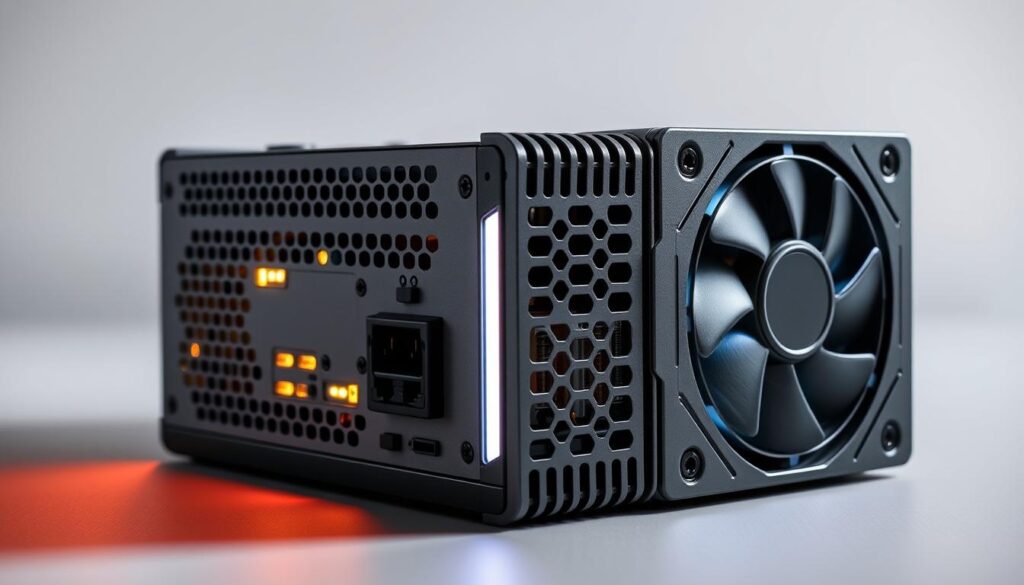
The be quiet! StraightPower 12 stands out as a top contender. With its Platinum efficiency rating, it ensures minimal energy waste and lower operating costs. Its near-silent operation makes it ideal for noise-sensitive environments12.
Another excellent option is the ENERMAX PlatiGemini 1200W. It achieves up to 93.2% average efficiency, making it a solid choice for high-demand configurations. Its customizable RGB lighting adds a touch of personalization8.
| Model | Wattage | Efficiency | Warranty |
|---|---|---|---|
| be quiet! StraightPower 12 | 1000W | 80 Plus Platinum | 10 years |
| ENERMAX PlatiGemini | 1200W | 93.2% Efficiency | 10 years |
| Cooler Master V SFX PLATINUM | 1100W | 80 Plus Platinum | 7 years |
Factors like efficiency, warranty, and build quality separate top picks from the rest. For example, the Cooler Master V SFX PLATINUM 1100 offers a compact design with a 92mm fan for cooling, making it suitable for smaller builds13.
For more insights on selecting the right unit, explore this comprehensive guide. Additionally, learn about the benefits of a high-capacity PSU for demanding setups.
Design and Build Quality in Modern PSUs
The design and build quality of modern PSUs play a pivotal role in ensuring system stability and longevity. Premium materials and thoughtful engineering are essential for handling high loads and maintaining efficiency. Manufacturers focus on durability, using components like Japanese capacitors and robust chassis to enhance reliability14.
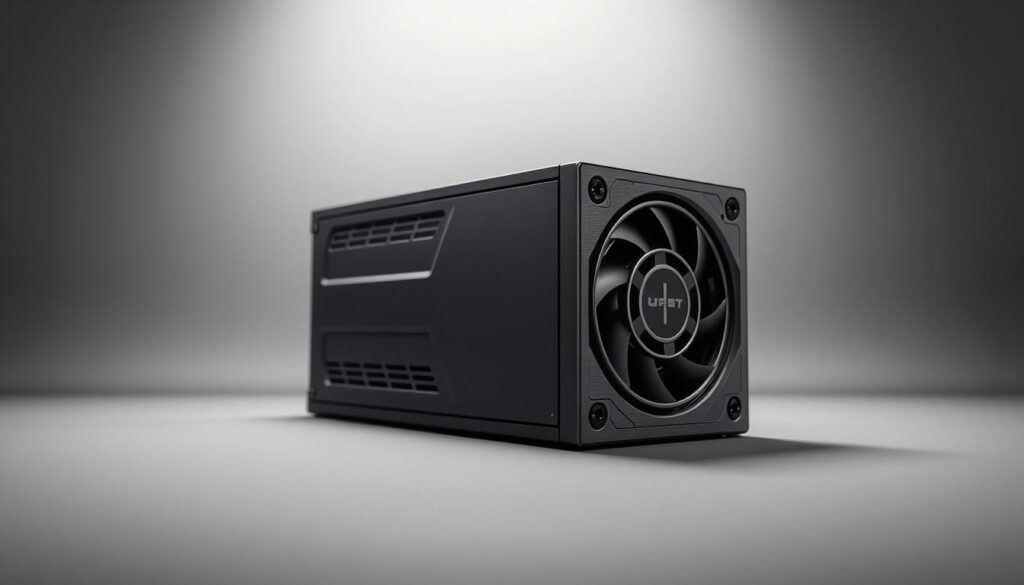
Thermal Management and Noise Control
Effective thermal management is critical for maintaining performance and extending the lifespan of a PSU. Advanced cooling systems, such as hybrid fan modes, ensure optimal airflow while minimizing noise. For example, the Lian Li EG1000 Platinum ATX 3.1 PSU operates quietly below 300 Watts, making it ideal for noise-sensitive environments14.
Modern PSUs often feature fanless modes at low loads, reducing noise levels significantly. The ASUS ROG Thor 1000W Platinum II, for instance, boasts a Lambda A++ noise rating, ensuring near-silent operation even under moderate loads15.
Real-world testing shows that units like the Seasonic Vertex GX-1200 maintain low noise levels up to 50% load, making them suitable for high-performance systems16. This balance of cooling efficiency and acoustic performance is a hallmark of premium PSUs.
Design features like cable sleeving and modularity also contribute to better airflow and easier installation. Fully modular designs, such as those in the MSI MAG A850GL, allow users to connect only the necessary cables, reducing clutter and improving thermal performance15.
For more insights on selecting a PSU that meets your system’s needs, explore this comprehensive guide on high-performance components.
Compatibility with ATX 3.0 / ATX 3.1 Standards
The evolution of ATX standards has introduced significant changes in PSU compatibility and performance. Modern systems demand higher efficiency and reliability, making the transition to ATX 3.0 and 3.1 standards essential for future-proofing your build17.
Understanding Connector Types
ATX 3.0 introduced the 12VHPWR connector, designed to handle up to 600 watts for high-performance GPUs. However, the ATX 3.1 specification renamed it to 12V-2×6, though the physical cable remains unchanged17. This evolution ensures better compatibility with emerging hardware standards.
Modern PSUs now offer flexibility with either a 12V-2×6 header or dual 8-pin connectors, ensuring compliance with both ATX 3.0 and 3.1 standards17. This adaptability simplifies upgrades and reduces compatibility issues.
Future-Proofing Your Build
Investing in an ATX 3.1-compliant PSU ensures your system can handle future hardware demands. These units feature improved transient response, with a peak of 150% instead of the 200% required by ATX 3.017. This reduces stress on components and enhances longevity.
Additionally, ATX 3.1 PSUs offer a maximum hold-up time of 12ms, compared to the 17ms minimum in ATX 3.017. This ensures stability during power fluctuations, making them ideal for high-performance setups.
“Choosing a PSU with ATX 3.1 compliance ensures your system remains ready for future hardware advancements.”
| Standard | Connector Type | Peak Transient Response | Hold-Up Time |
|---|---|---|---|
| ATX 3.0 | 12VHPWR | 200% | 17ms |
| ATX 3.1 | 12V-2×6 or 2x 8-pin | 150% | 12ms |
For more insights on ATX 3.0 compatibility, explore this detailed discussion.
Physical Considerations and Case Compatibility
Ensuring physical compatibility between your PSU and case is a critical step in building a stable system. Mismatched dimensions can lead to installation issues, poor airflow, and even hardware damage. Always verify the form factor of both components before making a purchase18.
Standard ATX PSUs measure approximately 150mm in width and 86mm in height, while SFX units are smaller at 125mm by 63.5mm. Compact builds often require SFX or Flex-ATX models to fit limited spaces18. Measure your case’s PSU bay and compare it with the manufacturer’s specifications to ensure a proper fit.
PSU length is another key factor. High-wattage units can exceed 180mm, requiring cases with ample clearance. Ensure there’s at least 200mm of space for optimal installation and airflow19. Modular designs can also help reduce clutter, improving thermal performance.
Airflow and cooling are directly impacted by PSU placement. Units with bottom-mounted fans require unobstructed ventilation to prevent overheating. Cases with dedicated PSU shrouds or compartments enhance cooling efficiency20.
For more insights on selecting the right computer power supply, explore this detailed guide. Proper physical compatibility ensures your system runs smoothly and remains future-proof.
Quick PSU Shopping Tips for Gamers
Choosing the right wattage for your system ensures stability and avoids unnecessary costs. Gamers often face the dilemma of selecting a PSU that meets their needs without overspending. Understanding your system’s requirements is the first step toward making an informed decision21.
Sizing Your PSU for Optimal Performance
Accurately calculating your system’s power needs is crucial. Use reputable PSU calculators like WhatPSU or Newegg’s Power Calculator to estimate wattage based on your CPU and GPU combinations21. For example, a mid-range system with an AMD Ryzen processor and an NVIDIA RTX 4060 typically consumes around 350W under load8.
Modern PSUs operate most efficiently at around 50% of their rated capacity. This means a 600W unit is ideal for a system that peaks at 300W8. Oversizing can lead to inefficiency, especially at low loads below 15%8.
Avoiding Overestimation in Wattage Selection
Many gamers overestimate their wattage needs, often opting for 1000W units when they’re unnecessary. For most systems with a mainstream CPU and a single GPU, a PSU between 500 and 650W is sufficient8. High-end setups with components like the Intel Core i9-14900K and NVIDIA RTX 4090 may require up to 800W8.
Balancing cost and performance is key. Premium models like the NZXT C1000 PSU offer high efficiency and modularity, but they may not be necessary for every build13.
“A well-sized PSU ensures your system runs smoothly without wasting energy or money.”
| System Type | Recommended Wattage | Example Components |
|---|---|---|
| Mid-Range | 500-650W | AMD Ryzen 5, NVIDIA RTX 4060 |
| High-End | 750-1000W | Intel Core i9, NVIDIA RTX 4090 |
By following these tips, you can select a power supply that meets your system’s needs while avoiding unnecessary expenses. Proper sizing ensures stability, efficiency, and longevity for your hardware21.
Understanding Testing and Certification Insights
Testing and certification processes for PSUs involve rigorous methodologies to ensure reliability and performance. These evaluations are critical for verifying that a unit meets industry standards and performs optimally under various conditions22.
Experts use advanced tools like Maynuo programmable loads and Rigol oscilloscopes to measure stability and ripple. These devices provide precise data on how a PSU handles different loads, ensuring it delivers consistent power without fluctuations23.
Objective Metrics and Benchmarks
Objective metrics such as true RMS values and efficiency percentages are determined through controlled testing environments. For example, 80 PLUS certification mandates that PSUs must be at least 80% efficient at 20%, 50%, and 100% of their rated load23.
Cybenetics certification includes twelve test points for efficiency measurements, covering no load up to 110% load in 10% increments. This comprehensive approach ensures that PSUs perform reliably across a wide range of conditions23.
Importance of Professional Testing Equipment
Professional testing equipment plays a vital role in evaluating PSU performance. Tools like programmable loads and oscilloscopes provide detailed insights into transient response and ripple, which are critical for maintaining system stability24.
Controlled environments are essential for thermal and noise testing. These settings allow experts to simulate real-world conditions, ensuring that PSUs operate efficiently and quietly under heavy loads24.
“Understanding these testing standards helps in making informed, data-driven purchasing decisions.”
For more insights on high-performance components, explore our detailed guide on the latest hardware advancements.
Conclusion
Choosing the right components for your system ensures peak performance and longevity. A high-quality power supply is essential for maintaining stability and reliability, especially in demanding setups. Throughout this article, we’ve explored key features like efficiency ratings, safety protections, and compatibility with modern standards like ATX 3.0.
Expert reviews and objective data provide valuable insights when selecting a PSU. Features such as modular designs, advanced cooling systems, and robust warranties ensure your build remains future-proof. For example, units like the FSP Hydro Ti Pro offer exceptional efficiency and quiet operation, making them ideal for high-performance systems25.
Before making a decision, use tools like PSU calculators to determine your system’s exact needs. This ensures you choose a unit that balances performance and cost. For more insights on optimizing your build, explore our guide on modern gaming technologies.
By following these guidelines, you can confidently select a PSU that meets your system’s requirements, ensuring smooth operation and long-term reliability.
FAQ
What makes a 1000W unit suitable for high-performance builds?
How important is efficiency in a PSU?
Should I choose a modular or non-modular design?
What is ATX 3.0 compatibility, and why does it matter?
How do I determine the right wattage for my system?
What role does thermal management play in PSU performance?
Are there specific brands known for reliability?
What safety features should I look for in a PSU?
How does noise level impact the user experience?
What is the significance of warranty length?
Source Links
- Do You Really Need A 1000W Power Supply For Gaming PC – https://voltapc.sg/do-you-really-need-a-1000w-power-supply-for-gaming-pc/?srsltid=AfmBOorYfHio3LLojp-BEbZqtzsSmKdrnVIyMQf589Hw1-JVJ9-E0yn4
- The Ultimate Guide to Choosing the Best Power Supply for Your Gaming PC – https://gamemaxpc.com/pc-power-supply/3797.html
- Do You Really Need A 1000W Power Supply For Gaming PC – https://voltapc.sg/do-you-really-need-a-1000w-power-supply-for-gaming-pc/?srsltid=AfmBOorb3A7fBkLUBBrDBKUZgaCqb0dh-NRxazicpINKDL6ef4ccwMGs
- How to choose the best PC power supply – https://www.pcworld.com/article/456490/how-to-pick-the-best-pc-power-supply.html
- Explaining the CORSAIR PSU Lineup (2023) – https://www.corsair.com/us/en/explorer/diy-builder/power-supply-units/explaining-the-corsair-psu-lineup/?srsltid=AfmBOoreh_Dq0gJdARk-2903hbzwvQIJMfcVUFENpLeY_utcF1nbuYYb
- Do You Really Need A 1000W Power Supply For Gaming PC – https://voltapc.sg/do-you-really-need-a-1000w-power-supply-for-gaming-pc/?srsltid=AfmBOopmTiUSEotrLS9906udY8bLtXuTGA6L1JMm37d6erv79n96eo1f
- The best power supplies for your GeForce RTX 50 series graphics card – https://rog.asus.com/us/articles/guides/how-to-choose-a-power-supply-for-your-new-gaming-pc/
- Best Power Supplies 2025 – https://www.tomshardware.com/reviews/best-psus,4229.html
- The Best 1000W PSUs In 2025 – Tested With Benchmarks – Tech4Gamers – https://tech4gamers.com/best-1000w-psu/
- 10 Best 1000W Power Supply For High-Powered PCs – https://www.electronicshub.org/best-1000w-power-supply/
- Best Power Supply Units for High-performance Gaming PC – https://directmacro.com/blog/post/best-power-supply-units-for-gaming-pc?srsltid=AfmBOop3Z6TvZd7aKv9v8pfXTkYx4epXrNx0ypj6YOnARVmR5Vi1XBIj
- The Best PSUs over 1000W for Enthusiasts in 2024 – https://gamerant.com/best-psus-over-1000w/
- Best PC Power Supply: Top PSUs for Your Gaming PC – IGN – https://www.ign.com/articles/best-power-supply
- The Lian Li EDGE EG1000 1000W ATX 3.1 PSU Review: Power On The Edge – https://www.anandtech.com/show/21463/the-lian-li-edge-eg1000-1000w-atx-3-1-psu-review-power-on-the-edge
- The Best PSUs For Your Gaming PC in 2024 – https://gamerant.com/best-psu-gaming-pc/
- Best Power Supplies For Gaming PCs – https://www.electronicshub.org/best-power-supplies-for-gaming-pcs/
- Should I get an ATX v3.1 PSU, or will an ATX v3.0 be fine? Everything you need to know! – Hardware Busters – https://hwbusters.com/quick-tips/should-i-get-an-atx-v3-1-psu-or-an-atx-v3-0-will-be-fine-everything-you-need-to-know/
- Ultimate Guide to Computer Power Supply: ATX, SFX, TFX, & EPS – Jackery – https://www.jackery.com/blogs/knowledge/computer-power-supply?srsltid=AfmBOooyoQvBil42pV6KpXlvB_ZvVY31BzbEH83ZuAh1zVXf90BsdMNS
- What PSU is Recommended for the RTX 5090 GPU? – 9meters – https://9meters.com/technology/pc/what-psu-is-recommended-for-the-rtx-5090-gpu
- Best power supplies for RTX 4090 in 2024 – https://www.xda-developers.com/best-power-supplies-for-rtx-4090/
- What Size of Power Supply Do I Need for a Gaming PC? – https://apexgamingpcs.com/blogs/apex-support/what-size-power-supply-gaming-pc
- Best PC power supply: top PSUs for gaming and more – https://www.techradar.com/news/best-pc-power-supply
- What is a PSU: Power Supply Units explained – https://www.corsair.com/us/en/explorer/diy-builder/power-supply-units/what-is-a-psu-power-supply-units-explained/?srsltid=AfmBOoqkAqEove-7-e3Q8Q0KAj32FTri5KXYr-eLWXXV9MoKOf54DT3a
- How to Choose the Right Power Supply for Your PC – PC Perspective – https://pcper.com/pcper-article/choose-right-power-supply-pc/
- The FSP Hydro Ti Pro 1000W PSU Review: Titanium Shines for FSP’s Flagship Power Supply – https://www.anandtech.com/show/21148/the-fsp-hydro-ti-pro-1000w-psu-review/5

